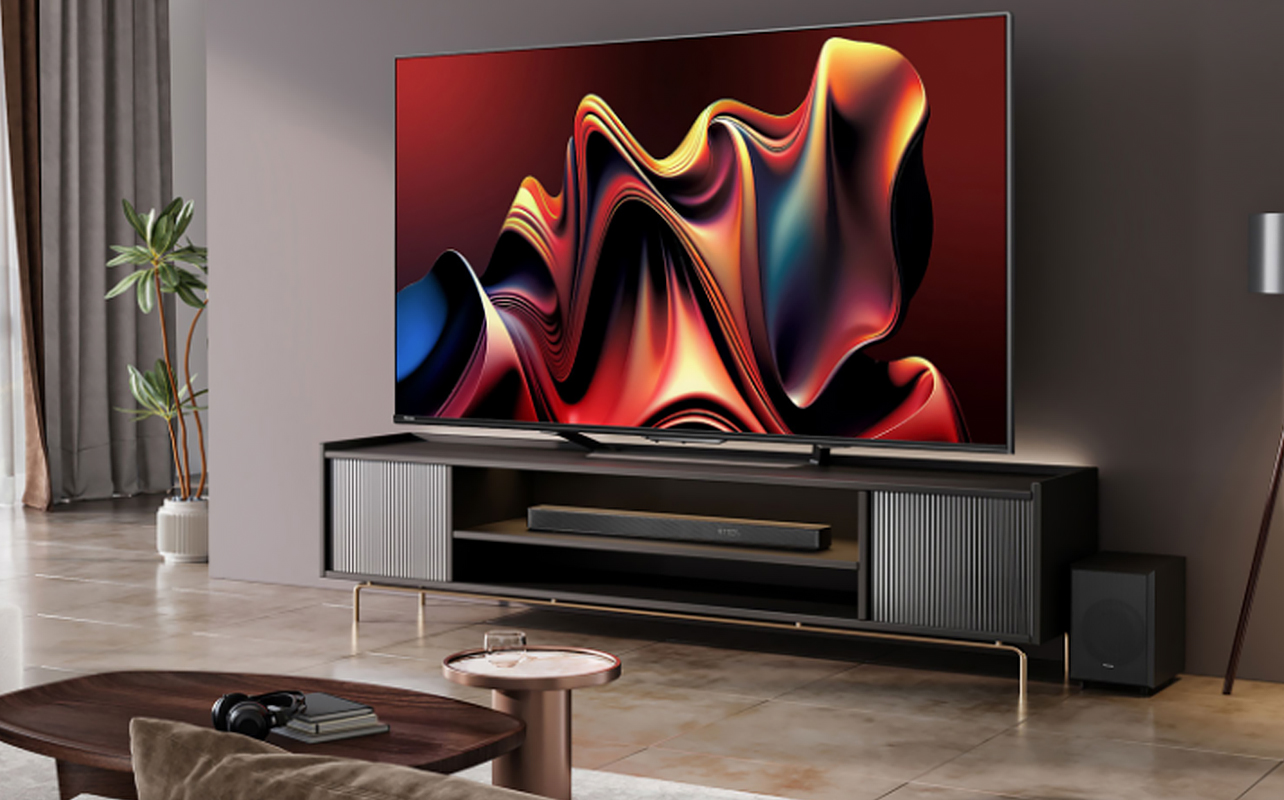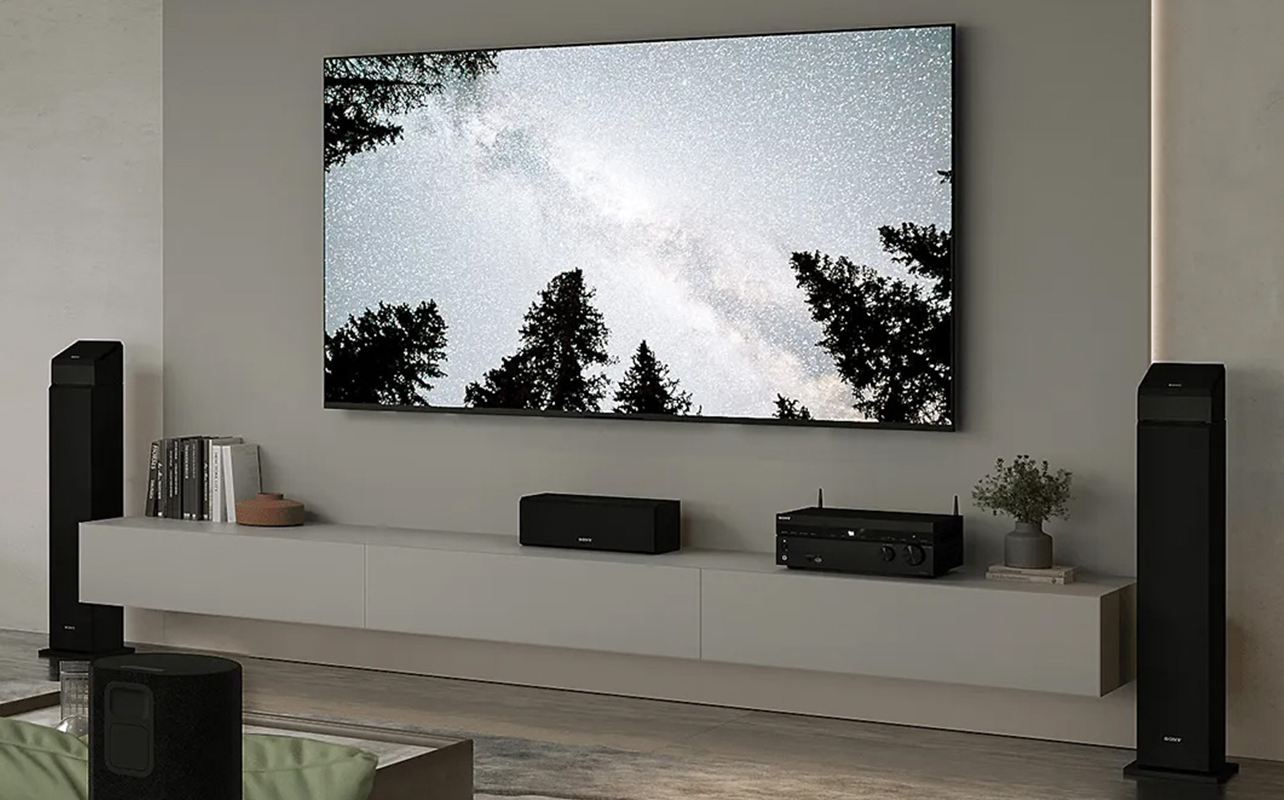Thinking of upgrading to a 65-inch TV? You’re probably wondering just how big it really is and whether it’ll fit in your space. A 65-inch screen sounds massive. But is it truly too big for your setup? Before you make a decision, it’s important to understand not just the size of the screen, but how it fits within your room layout and viewing distance requirements.
This article breaks down the size of a 65-inch TV, how to measure your room, and tips on installation to help you make the right choice.

What are the dimensions of a 65-inch TV?
How wide is a 65-inch TV? TVs are measured diagonally from corner to corner, not across its width or height. This means the actual width of the TV is less than 65 inches.

Typical dimensions
- Width: 56.7 inches (144 cm)
- Height: 32.0 inches (81.3 cm)
- Depth (without stand): 2-3 inches (5-7 cm), depending on the model
Understanding the difference between screen size and physical dimensions is crucial when choosing a TV. While a 65-inch TV refers to the diagonal measurement of the screen, the actual width and height are what truly determine if it will fit in your space. Misjudging these dimensions can lead to an awkward setup or even the need to rearrange your room.
How much room do you need for a 65-inch TV?
With a 65-inch TV, you can enjoy an immersive experience. But, if your room is too small or your seating is too close, you may not get the best picture quality or comfort. Proper spacing ensures you enjoy your TV without strain or awkward positioning. Follow recommended viewing distances and know how resolution impacts placement. Plus, learn some quick practical steps to measure your space before making a purchase.
Ideal viewing distance
To get the best viewing experience, you’ll need to sit at the right distance from the screen.
- Recommended range: 8 to 13.5 feet (2.5 to 4 metres)
- Why it matters: Sitting too close can cause eye strain, while sitting too far can diminish the immersive experience.
Viewing distance by resolution
Your TV’s resolution can also affect the ideal viewing distance, as higher resolutions allow for closer viewing without a loss in clarity.
- 4K TVs: Sit closer (8-10 feet) for maximum clarity.
- 1080p TVs: Sit farther (10-13.5 feet) to avoid noticing individual pixels.

Can’t decide between 65-inch and 75-inch TV?
Check out our blog comparing both TV sizes. Learn about what to consider to help you choose the perfect screen size for your home?
Actionable tips for measuring your space
Measure your space properly. Make sure that your new 65-inch TV fits seamlessly into your room without overwhelming the layout or causing discomfort during viewing.
Step 1: Measure the available wall space where you plan to mount or place the TV. Ensure it’s at least 56.7 inches wide, leaving extra space for ventilation and cable management. Many modern OLED and QLED TVs generate more heat, requiring adequate airflow. Placing a TV inside a tight cabinet or against a wall with minimal space can cause overheating or performance issues over time.
Step 2: Use painter’s tape or a cardboard cutout to outline the TV’s dimensions on your wall to get a real sense of its size.
Step 3: Check your viewing distance and allow at least eight feet of space between the TV and your seating area.
What to consider before purchasing a 65-inch TV
Beyond just the physical size, there are other important considerations you’ll want to factor in. Assess the layout of your room, the TV’s specifications, and how it integrates with your home entertainment setup.

Room size and layout
Consider the size of your room to ensure it accommodates the screen. A smaller room may make the TV feel overwhelming rather than immersive, while a larger room may require strategic placement for optimal viewing. Additionally, leave enough space for ventilation and cable management to prevent overheating and clutter.
Your room’s layout plays a crucial role in how well a 65-inch TV fits into the space. Take into account furniture placement, seating arrangements, and wall mounting options to create a balanced setup. Position the screen to minimize glare from windows or lights. And plan a seating arrangement to provide a comfortable and immersive viewing experience.
TV specifications
The right TV isn’t just about size—it’s also about features that enhance your viewing experience. Here are some key specs to factor in and why they matter:
- Resolution: 4K vs. 1080p. A 4K resolution provides sharper and more detailed images, making it ideal for closer viewing distances and high-definition content.
- Display type: OLED, QLED, LED—each offers different benefits. OLED provides deep blacks and vibrant colours, making it great for cinematic experiences. QLED delivers high brightness, perfect for well-lit rooms, while standard LED models are often more budget friendly.
- Connectivity: Make sure the TV has enough HDMI and USB ports for your external devices, such as gaming consoles, streaming devices, and sound systems. This prevents the hassle of constantly swapping cables.
- Smart features: Many TVs nowadays come with built-in apps, voice control, and streaming services, allowing you to access content conveniently without extra devices.
- Refresh Rate: A higher refresh rate (e.g., 120Hz) ensures smoother motion, reducing blurring in fast-paced content like sports and gaming. However, many TV models now use motion smoothing (frame interpolation) rather than native 120Hz refresh rates. For gaming and fast-paced content, a TV with HDMI 2.1 and true 120Hz (not software-enhanced) is preferable.
Mounting vs. TV stand for a 65-inch TV
Choosing between mounting your TV on the wall or placing it on a stand is an important decision that impacts both aesthetics and functionality. Each option has its own advantages and drawbacks, depending on your space, viewing preferences, and installation flexibility. Here are some pros and cons of both methods to help you decide which setup is right for you.

Using a TV mount
Mounting your TV on the wall can create a clean look and free up valuable floor space. However, it requires careful planning and the right wall support to ensure a secure installation. It’s best for minimalist homes or rooms where saving floor space is a priority.
Pros:
- Frees up floor space, making the room feel more open and less cluttered.
- Provides a sleek, modern aesthetic, perfect for minimalist setups.
- Adjustable viewing angles with tilt/swivel mounts allow for better positioning.
Cons:
- Requires a sturdy and compatible wall for mounting, which may not be available in all spaces.
- Installation is more complex and may require professional assistance.
- Permanent setup—removing the mount later may leave holes or wall damage.
Using a TV stand
A TV stand provides flexibility and additional storage options but requires sufficient floor space and careful placement to maintain an organized look. It’s best for rooms with ample floor space or those needing extra storage for entertainment devices.
Pros:
- Simple, hassle-free setup—no need to drill into walls.
- Movable and flexible, allowing you to reposition the TV if needed.
- Often includes storage space for media devices, gaming consoles, and decor.
Cons:
- Takes up floor space, which can make small rooms feel more crowded.
- Can contribute to a cluttered aesthetic if not organized properly.
Installation tips
- If mounting, ensure the wall can support the TV’s weight and use a VESA-compatible mount.
- Consider professional installation services like Geek Squad. Its TV & Home Theatre Services can help install, set up, or mount your home theatre system whether you bought from Best Buy Canada or elsewhere.
Making the most of your 65-inch TV

A 65-inch TV delivers an immersive, cinematic experience, making movies, sports, and gaming feel larger than life. However, ensuring that it fits well within your space is just as important as choosing the right model. Proper planning for viewing distance, room layout, and installation method can make all the difference in maximizing your enjoyment while maintaining a comfortable and functional living area.
Whether you decide to mount it on the wall for a sleek, modern look or place it on a sturdy TV stand with extra storage, taking the time to measure your space and evaluate your setup options will prevent any post-purchase regrets. With the right approach, a 65-inch TV can be a game-changer for your home entertainment.
Ready to bring home your 65-inch TV? Find our wide range of 65-inch to 69-inch TVs at Best Buy Canada.
Frequently asked questions
1. How wide is a 65-inch TV?
A 65-inch TV is typically 56.7 inches (144 cm) wide, though this can vary slightly by model. When planning your setup, it’s important to consider additional space for ventilation, cable management, and any surrounding decor or sound systems that may impact placement. Measuring your available space beforehand can help prevent an overcrowded or unbalanced setup.
2. Is a 65-inch TV too big for my living room?
It depends on your room size and viewing distance. If your seating area is at least eight feet away, a 65-inch TV should provide a comfortable and immersive viewing experience without feeling overwhelming. However, if your room is small or you’re sitting too close, the screen may feel too large, making it difficult to take in the entire picture at once and potentially causing eye strain.
3. Can a 65-inch TV fit on a standard TV stand?
Yes, as long as the stand is at least 56 inches wide and can support the TV’s weight. Some stands come with built-in storage or cable management solutions, which can help keep your entertainment area organized. Additionally, consider the depth of the stand to ensure the TV sits securely, especially if it has a central pedestal-style base rather than wide-set legs.
4. What’s the best height to mount a 65-inch TV?
The optimal height is when the centre of the screen is at eye level when seated, which is typically 42-48 inches from the floor. Mounting the TV too high can cause neck strain, while placing it too low may lead to an awkward viewing angle. If you have reclining seats or a specific seating arrangement, adjust the height accordingly for the most comfortable and immersive experience.
5. What is the difference between a 65-inch and 55-inch TV?
A 65-inch TV has roughly 40% more screen area than a 55-inch model, making a noticeable difference in screen size. This extra screen real estate enhances the viewing experience, especially for movies, sports, and gaming, by providing a more immersive and cinematic feel. For more details, check out our feature comparing 55-inch and 65-inch TV.



![22nd Feb: Rikuoh (2017), 10 Episodes [TV-PG] (6/10)](https://occ-0-937-2705.1.nflxso.net/dnm/api/v6/Qs00mKCpRvrkl3HZAN5KwEL1kpE/AAAABfFFhoJiO7DNYbu0LVqX93GERdDrCUaTe2tCjFCho5AJW2cwQFIWh44phiYY6A0TFUAz34wINaejf4IJg2kJVbWksYt6lvAO_TR77GMZLhBR7--ySQu9X06TdXgBrP0AS9yMiS8kBz0nfZ5z7IeL5pcCpT0g3X7KSHe4M211MWHWB6zLFs16ZLJM2lyqf6LZfKpBt2rOFzGcTKqiaMzXXs5tLx0bkMxTBwxfj9lMsF7wsrYFHReyjw5Zl6Zb6S13OIncJWmm46uiYyQPX8kpr0wdHEONMA.jpg?r=523)


![22nd Feb: 8 Mile (2002), 1hr 50m [R] – Streaming Again (6.6/10)](https://occ-0-937-2705.1.nflxso.net/dnm/api/v6/Qs00mKCpRvrkl3HZAN5KwEL1kpE/AAAABWEDYCWNGHi3zk1BUcC32YuQContW5zwaowX6jCEHc1jGcX-aeqbR5XPTzHYaYWg4u5hWZ8XaLVxXjcQDwiH4y5MajKj8cPLdSC1.jpg?r=166)











